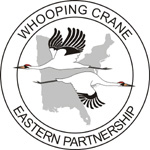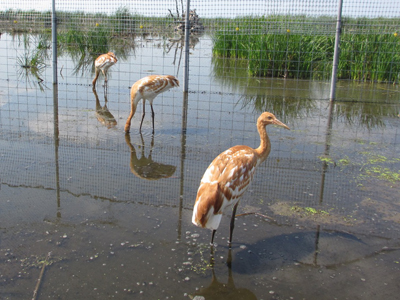 |
| Share this video with your friends and help us spread the word that disturbing, harassing or killing Whooping Cranes is a crime. |
 Report a Whooping Crane sighting Report a Whooping Crane sighting |
 Make a gift to support Whooping Crane conservation. |
Media Contact: Joan Garland, ICF Outreach Coordinator, 608-381-1262
Six young Whooping Cranes began their ultralight-led migration September 28th from the White River Marsh State Wildlife Area in Green Lake County, Wis. This is the 12th group of birds to take part in a project led by the Whooping Crane Eastern Partnership (WCEP), an international coalition of public and private groups that is reintroducing this highly imperiled species in eastern North America, part of its historic range.
WCEP partner Operation Migration will use two ultralight aircraft to lead the juvenile cranes through Wisconsin, Illinois, Kentucky, Tennessee, Alabama, and Georgia to reach the birds’ wintering habitat at St. Marks National Wildlife Refuge (NWR) along Florida’s Gulf Coast. The cranes are currently in Winnebago County, Ill.
“Despite the fact that we have done this before, each year we learn something new about these wonderful birds,” said Joe Duff, CEO of Operation Migration and leader of the ultralight team. “This year’s flock seems more attentive, and we hope to make better progress. Our target is to arrive in Florida before Christmas.”
In addition to the six birds being led south by ultralights, biologists from WCEP partner, International Crane Foundation, are currently rearing six Whooping Crane chicks at Horicon NWR in Dodge County, Wis. The birds will be released later this fall in the company of older cranes from whom the young birds will learn the migration route south. This is the eighth year WCEP has used this Direct Autumn Release (DAR) method.

Whooping Cranes that take part in the ultralight and DAR reintroductions are hatched at the U.S. Geological Survey’s Patuxent Wildlife Research Center in Laurel, Md., and at the International Crane Foundation in Baraboo, Wis. Chicks are raised under a strict isolation protocol, and to ensure the birds remain wild, handlers adhere to a no-talking rule and wear costumes designed to mask the human form.
The 12 ultralight-led and DAR chicks are joining two wild-hatched chicks in the 2012 cohort. These two wild-raised chicks will follow their respective parents on migration. In addition to the 14 juvenile cranes, 102 Whooping Cranes are currently in the eastern migratory population.
Whooping Cranes were on the verge of extinction in the 1940s. Today, there are only about 600 birds in existence, approximately 445 of them in the wild. Aside from the WCEP birds, the only other migratory population of Whooping Cranes nests at Wood Buffalo National Park in northern Alberta, Canada and winters at Aransas NWR on the Texas Gulf Coast. A non-migratory flock of approximately 20 birds lives year-round in the central Florida Kissimmee region, and an additional 17 non-migratory cranes live in southern Louisiana.
WCEP asks anyone who encounters a Whooping Crane in the wild to please give them the respect and distance they need. Do not approach birds on foot within 200 yards; remain in your vehicle; do not approach in a vehicle any closer than 100 yards. Also, please remain concealed and do not speak loudly enough that the birds can hear you. Finally, do not trespass on private property in an attempt to view or photograph whooping cranes.
Whooping Crane Eastern Partnership founding members are the International Crane Foundation, Operation Migration, Inc., Wisconsin Department of Natural Resources, U.S. Fish and Wildlife Service, the U.S. Geological Survey’s Patuxent Wildlife Research Center and National Wildlife Health Center, the National Fish and Wildlife Foundation, the Natural Resources Foundation of Wisconsin, and the International Whooping Crane Recovery Team.
Many other flyway states, provinces, private individuals and conservation groups have joined forces with and support WCEP by donating resources, funding and personnel. More than 60 percent of the project’s budget comes from private sources in the form of grants, public donations and corporate sponsors.
